The US
Lagos-Besteiro Family:
A History-3
1921 to 1934: Paterson - the single
years
By Emilito
Rev. 2005-02-28
home
| Family
Stories, Pictures, etc
| Family
Trees
| Rugby Stories, Data,
Pictures, etc
| Miscellaneous
To be constructed
Everything
below is in "scribble" form has been and put up here solely for the
purpose of
letting family members contribute stories, recollections, parents'
recollections, etc. Hopefully Emilito has better quality control
than this.
As the Lombardo
moving truck carrying the Lagos family rolled up to 321 Market Street
sometime in 1921, a 40+ year period of geographic stability was
beginning;
all members of the family would live in or within 5 miles of Paterson
until
Emilito began the Diaspora with the first permanent family move, to
Bethlehem, PA in
March 1966.
Maina and Papa were in the prime of their lives - she 37, he 41.
Carmen/Carmita
was
10, Manuel/Manolo/Manny 9, Victorina/Vicky 8, Dolores/Lolita/Dee 4,
Carlos/Carlitos/Charlie 3, and Josephine/Piti/Jo 1. There would
be no additions for nearly two decades to this locally unconnected
self-enclosed nuclear family.
But there was no lack of things to do - and a few funny stories!
Paterson
Paterson, NJ, holds an
important place in US history - it is the first city designated for the
development of industry. Wikipedia's
article on Alexander
Hamilton notes that "Hamilton was among the
first to recognize the larger transformations of industry and
capitalism of his era -- in particular
the trend toward larger-scale manufacturing financed through credit. In
1778 he visited the
Great Falls of the Passaic
River in
northern New
Jersey and saw
that the falls could one day be harnessed to
provide power for a manufacturing center on the site. As Secretary of
Treasury, he put this plan into motion, helping to found
the Society
for the Establishment of Useful Manufactures,
a private
corporation that would use the power of the falls to operate mills.
Although the company did not succeed in its original purpose,
it leased the land around the falls to other mill ventures and
continued to operate for over a century and a half. The city which
grew on the spot of Hamilton's vision, Paterson, New
Jersey became one
of the most important manufacturing centers for cotton, steel and silk, until its decline after World
War II."

The Great Falls of the Passaic River
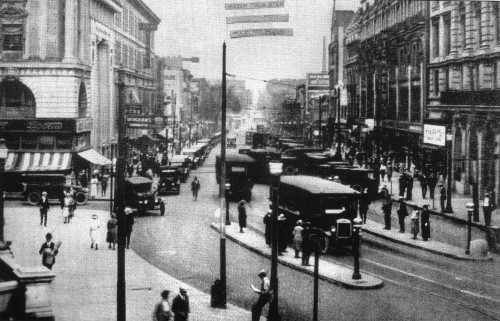
Market Street in the 1920s; Paterson City Hall is immediately to the
left of the photo.
A 10-minute walk down this street and one would be at the family's
first address, # 321.
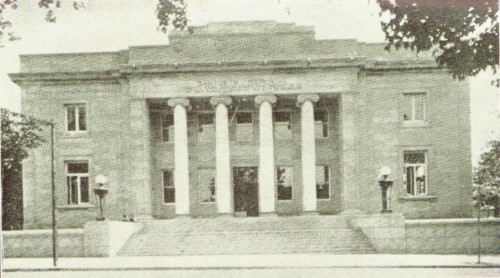
The Paterson Free Public Library, completed in 1905
This building was designed by [NAME], the person that designed the
Lincoln Memorial
Emilito finds it hard to imagine that his mother Carmen LAGOS BESTEIRO
did not spend a lot of time here.
Several
famous people hail from Paterson. One of them was faithful in
referring to his hometown throughout his film career. Lou
Costello, born in Paterson in March 1906, was busy building his career
with Bud Abbot during the time the family lived in Paterson; after
years of vaudeville, their first film came out in 1940.
Write
some background article on
Paterson, its history, what it was like in the 20s and 30s . . .
Include pictures of the Falls,
Quackenbush or Meyer Bros, a couple of
theaters "in the day"
A couple of pix of immigrant
families
Can I find the Morning Call (or was
it Evening News) article on history
of Paterson?
Schools in Paterson in the 20s/30s?

Abbot and Costello in "Who's on
First" - Note "Paterson Silk Stockings" Logo in Background
There
are many more pictures of Paterson, more background information, more
information on what it was like when the family moved there, more
famous Paterson personalities, to be found in
emilito.org -- click here to get there.
Lagos
Family Residences in Paterson
Most of the
information on the Paterson residences, below, comes
from Carmen, as recorded by Dolores' daughter Chippie in the 1992
family reunion book.
Can we figure out the
years of the houses?
Find out when houses were built?
[22nd Street and Lenox Ave for
sure are same buildings now as then - probably all but 315 Park. . . ]
"The
first home in Paterson
was at 321
Market Street
on
the second floor above a store. From here the children attended
their
first school in Paterson,
directly
across the street. At that time it was School 15, but it later
became
Eastside High School Annex and then School 11 of which Carmen
became the
first principal.
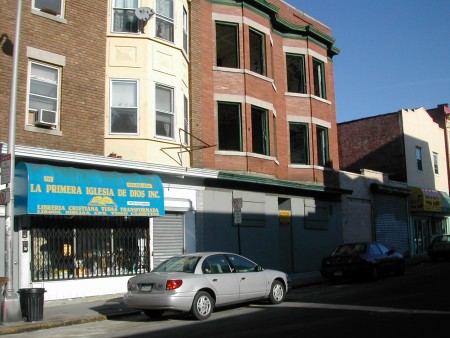
321 Market Street (building being reconstructed at right-center) on
1/1/2005

School 11, at 350 Market Street, from
its website
This (as School 15) was the first school the Lagos kids attended
Later Carmen was the first principal of the newly numbered School 11
Carmen again: "The family then moved to 307 Park Avenue,
also over a store, and then to 315 Park Avenue, a house I like best of
all the houses in which I've ever lived. It was a much bigger
house with servant's rooms upstairs. There were
never
servants, but at one time the first Maina [Victorina GRACIANI LORENZO,
see this Lagos-Besteiro history part
1 or part 2], was
living there.
She had a dresser cover with fringe on it and Aunt Dee used to go
upstairs when
no one was there and light one fringe, just to watch it burn. One
day, when she lit one it spread to the
others. She was so scared she went
downstairs and sat down to supper without saying a word.
A man rang the doorbell and told Papa that
flames were coming from the attic window.
The fire department put out the fire, which by then had damaged
the
room. The fire was blamed on a hot coal
from a passing train. That remained the
story until Aunt Dee decided to tell Maina the truth – in 1967."
Emilito comments:
"man, they were gullible. When I first heard this story, I
thought it had to do with 307, which itself is the 2nd building from
the tracks. 315 is the fourth. If it were possible for hot
coals from the train to get to 315, then 305 and 307 would probably
have
burned down by then."
Papa was naturalized on June 18, 1925 (15 years to the day before
Emilito's birth); his address was listed as 307 Park Avenue.
Emilito also notes
that this incident probably took place in 1927: his Aunt Dee
told him that when she finally told her mother in 1967 it had
been 40 years since she had nearly burned down the house.
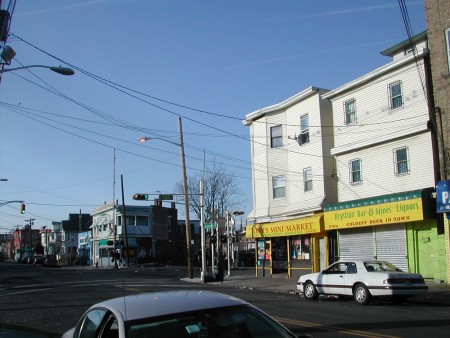
307 Park Ave is the 2nd building from the corner (E 22nd Street). Photo
taken 1/1/2005
The RR tracks run perpendicular to Park Ave just past the corner
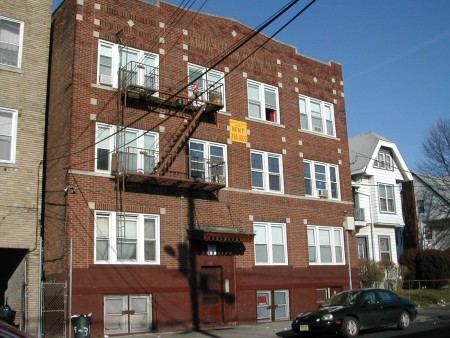
315 Park Avenue on 1/1/2005
307 Park Ave is to the left and E. 23rd Street is to the right
This building seems like a far more recent addition to the street.
Carmen: "After
that the family lived in two houses on 22nd Street,
across from School 24 which was also
the
'Normal School.'" She goes on to explain: "At one time there was
no special
education
provided for people to prepare for the teaching profession. The French developed a series of “norms” for
earning a certificate entitling a person to teach.
Because its courses were based on those
norms, such a school was called an “ecole normale.”
In our country the same was done and
translated to “normal school.”) Among
the neighbors on 22nd
Street
were Marguerite and Catherine Feeney.
Catherine would later become Catherine Carr, whose son Tom would
marry
Chippie."
Emilito picks this spot to digress to a moment in time sometime around
2002 when Chippie's husband Tommy Carr showed him an envelope and said
"You're the family expert - what was Aunt Vicky doing writing to my
mother in 1930 anyway?" Tommy thought it must have been Dee's
sister
Victorina Lagos, but Emilito looked at the signature and saw that it
was signed by "Victorina G. de Lagos!" Then he looked at the return
address on the
envelope which said "Victorina Graciani de Lagos." How in the
world did
Chippie's great grandmother hook up with someone who wasn't going to
interact with our family for 36 more years?
Well, it obviously had to do with the fact, as Carmen noted [2
paragraphs above], Tom's
mother had lived on 22nd Street. Since Victorina wrote "How you
must
have grown in the past two years!," Victorina's last visit to Paterson
must have been in 1928 (almost certainly her last visit ever, as she
died
in Havana in 1931). She signed it

Although Carmen didn't specify the houses, Dee and Jo said they were,
first 922 East 22nd, and then its next door neighbor 924. The
1930 census found the family at 922, where they were paying $55 per
month rent. As they left 22nd Street in 1931, their stay at 924
(they moved there because it had one more bedroom) must have been quite
brief.
With the information Emilito has gathered so far, he reckons we can
speculate as the when they were where. They arrived at 321 Market
Street sometime in 1921, probably mid-year. They were still there
in November 1922 when Victorina visited (from Ellis Island
Manifests). By April 1924, when Manuel, Victorina and her
grandson Ricardo visited, they were at 307 Park Avenue. They were
still there when Papa was naturalized on June 18, 1925. They were
in 315 Park by 1927 (could have been a year earlier) and at 922
2nd Ave by 1927 (possibly 1926) and still there in April 1930, and
between that date
and their move to Lenox Avenue in 1931 also spent some time living in
924 22nd Street.
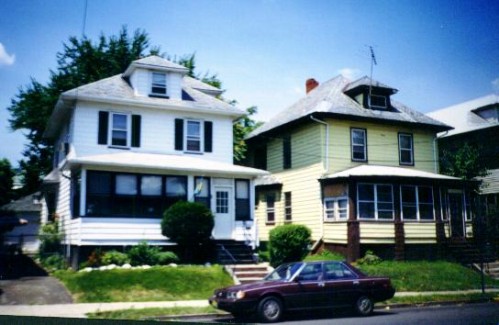
922 (left) and 924 E. 22nd Street in 2002
Carmen continued,
"In 1931
Maina and Papa purchased the house on Lenox
Avenue. The
tennis courts Papa had built helped to make it a gathering place for
the
children’s friends. (I’m sure Papa had
in mind keeping the children home when he had it built.)"
The older members of Emilito's generation spent lots of time at Lenox
Avenue and remember it well - this is where we gathered (sometimes
daily). By the time we came around, however (basically the 40s),
the "tennis court" was no longer functioning as such and was more like
a vacant lot, where we played "kick the can" and other children's
games. Apparently in the 1930s, however, it truly functioned as a
tennis court.
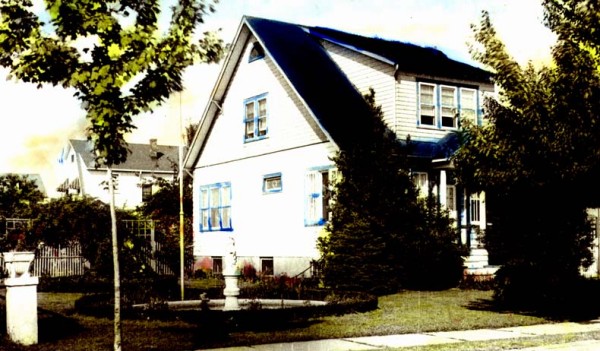
129 Lenox in the days of colorizing pictures (probably the 1930s)
The sculpture in the pond was done by well-known sculptor Gaetano
Federici.
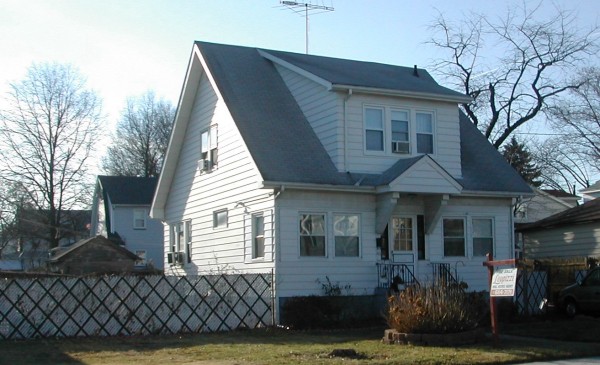
129 Lenox for sale on January 1, 2005
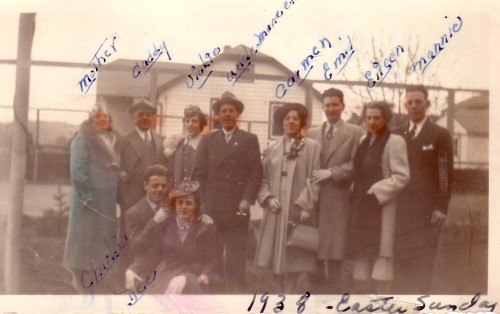
1938 family picture in front of tennis court. The house at 129
Lenox is behind the photographer
Currently there is a house on the lot where the tennis court was
Schools While in Paterson
Where the kids went before 1934 (or so)
15, others? St. Jos., St. Mary, Eastside HS,
Normal School, NYU, Nursing Schools
HS Yearbook Pictures et al
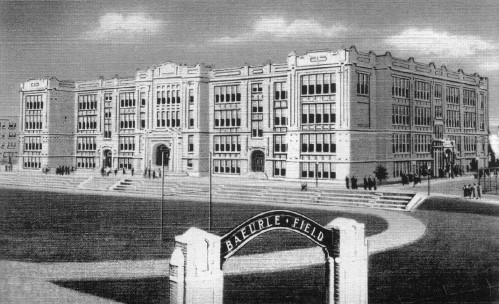
HS:
Carmen - graduated Eastside Jan 1927 (went elsewhere? when did Eastside
start?) - have pic? yearbook?
Manny - graduated Central - when? - have pic? -
other schools? Started at the #15 on Market Street
Vicky - graduated Central? - when? - have pic? - other schools? Started at the #15 on
Market Street
Dee - graduated
St. Mary's - 1935 - have pic - yes - she never went to public school -
St. Joseph Grammar school, etc.
Charlie - graduated St. Mary's - 1938 - have pic -
yes (exactly same as Jo - started a year later, then held back a year)
Jo - went to school in 22nd - #15? through 1st year
at Lenox, then to &graduated St. Mary's - 1938 - have pic -
yes xxdd
-----------------------------------------------------------------------------------------------------------------------------
The Manuel and
Victorina Saga Continues
The Ellis Island Records Database (www.ellisislandrecords.org)
stops in 1924, so we certainly miss some of the extensive visits of
Manuel LAGOS TOLEDO and his wife Victorina GRACIANI LORENZO that extend
throughout the decade, and later for Manuel. Nevertheless there
are two visits documented in the database, in 1922 and 1924.
Aunts Dee and Jo remembered that Manuel and Victorina actually lived in
Paterson - on Oak Street - for perhaps a year or more while the family
was on 22nd Street. As we know from Victorina's letter to
Catherine
Feeney that she had left around 1928, the most probable time was
1927-28. As we know from Dee's "arson" story that the family was
on Park Ave in 1927 one assumes that's about when they moved to 22nd
Street.
Interestingly,
on
the 1922 trip she was listed as "single." Now
it's true that on the original manifest the "S" was later
overwritten with "M," but she is also listed as living in Havana
with a
friend, "Mario García." (No,
it's not as potentially scandalous as it might seem; Mario was her
son-in-law, so she was living with her daughter Isabel and
her husband.) But where was Manuel? Manuel Lagos had arrived in
Paterson the month before Victorina. He came, however, on a ship
from Santiago, and he listed his
address
as that of a friend, Dr. Muin, in Santiago, Cuba (approximately 500
miles from Havana). Victorina noted that she was
coming to spend 6 months in the US; according to Manuel he was
coming for a year "to study." In 1924, however, they traveled
together (with her 7-year old grandson Ricardo Besteiro - whom we
called Richard) and were both listed as
living in Havana with Mario García as well as being residents of
the
US. Ricardo can be seen in the following photo taken on the day
of Dee's first communion on June 1, 1924.
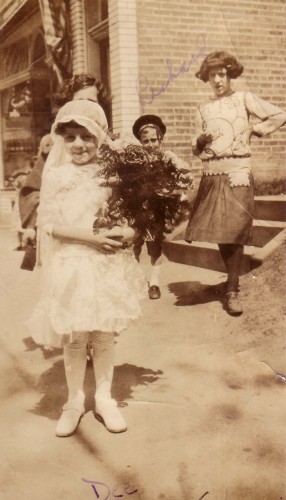 Photo taken on June 1,
1924, Dee's First Communion
Photo taken on June 1,
1924, Dee's First Communion
Little Boy
behind is Ricardo Besteiro, on the right is Carmen
Ricardo came from Cuba with his grandmother Victorina and her husband
Manuel
We also have a pretty good idea of when Victorina
returned to
Cuba for good. When Pepe GARCÍA BESTEIRO began to visit
Paterson about 1950,
Dee and Jo remembered they harbored some anger about his being born,
because when Victorina found out her daughter Isabel (Aunt Betty) was
pregnant with her first child (Pepe, born 15 October 1928), she (and
presumably tío Manuel - one never knows) left for
Havana to assist Isabel.
There just
have to be
stories behind these stories. Emilito's mother and her generation
were not very forthcoming about imperfections in the family, but
Emilito suspects that Manuel and Victorina's true story would have been
worth a novel.
POSTSCRIPT - Manuel. Although the family never saw Victorina
again, tío Manuel would return many times through the
1930s. Apparently he never returned after that - first there was
World War II, then - for some reason not known to anyone left alive -
the two brothers stopped communicating.
In August 1934, Papa took an emergency trip to Havana when he found out
his
brother Manuel had shot himself in a failed suicide attempt. When
he
left on this particular voyage, the kids accompanied him to the ship
and later they all remembered that the band was playing "For all you
know, we may
never meet again." Scheduled to return on the Morro Castle on the 8th
of September, Papa moved his trip up a few days when he decided Manuel
was OK. The Morro Castle - on his originally scheduled trip -
caught
fire off the shore of Asbury Park, NJ, and 134 people were killed.
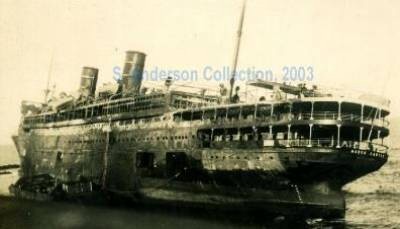
Morro Castle After Fire, 1934
Click on the picture to see other shots from the Steven Anderson
Collection
Papa's report on the cause of Manuel's attempted suicide? A
woman. Papa reported to Maina that "she looked just like Betty
Boop."
PREQUEL - Victorina. This is not all there is to say about
Victorina; Emilito notes that when she was 19 Victorina was
one of the most promising actresses on the Madrid stage. She gave it
all up to marry, and thus began our family lives.
Emilito, who believes Victorina's life, combined with that of
tío Manuel and also her eccentric sculptor father Francisco
Graciani AKA Grazziani, would probably make an interesting novel.
At the very least, it will be featured in an exclusive Emilito article on Victorina and her life.
link to 1881 site?
look
and see who Oscar's uncle is, he is line 28 on page 5, Oscar is
line 1 on page 6
------- put this whole thing together
------------
Funny Family Facts and
Fables
Much of what follows is taken from the book Emilito's cousin
Chippie put together for the 1992 Lagos family reunion (with
information provided by Carmen), with additions interspersed.
Carmen
writes: "Papa
always required the children to speak Spanish at home
and sadly this deterred Maina from mastering English to her
satisfaction [but see here for 1965
story]. Once
when Aunt Carmen told Papa that her teacher had
instructed her to speak English at home he explained: in the classroom
the
teacher is in charge and you will obey her.
Here, however, I am in charge and you will do as I say and that
includes
speaking Spanish at home.
"For
many years the Lagos Besteiro family continued to
observe the customs of Spain. Saints’ days were celebrated rather than
birthdays. Gifts were exchanged on the
Feast of the Three Kings, not on Christmas."
The
second part of the play Carmen wrote - to describe life on Lenox Avenue
- for her mother's 82nd birthday in 1966 was documented by Dolores'
daughter Chippie for the Lagos family 1992 reunion.
Aunt
Carmen (is standing in a corner, her pinky in her mouth,
reading a book)
Aunt Jo
and Uncle Charlie (are in another part of the stage,
fighting in pantomime)
Aunt
Dee (is crying – once in a while you can hear her sob)
Aunt
Vickie (dusting vigorously) -
You kids make such a mess
around the house.
Aunt
Jo (to Uncle Charlie) -
Leave me alone! If
you keep bothering me I’ll tell Papa that
Sister had to scold you three times today!
Uncle
Charlie –
You big mouth! I’ll knock your
block off!
Maina
(looks around, surveying the situation) -
¿Que pasa
aquí? Carmita,
saca el dedo de la boca y ves a ver
lo que pasa a esos muchachos.
Aunt Carmen (stamping
her foot) -
¡Nunca puedo leer! ¡Estos
chicos--! What’s the matter with you two? (walking up
to Aunt Jo and Uncle Charlie)
Maina
(to Aunt Dee) –
Y tú Lolita. ¿Por
que lloras? What’s the matter? Who has a
new dress now?
Uncle
Mannie (comes in carrying a football; he has a black
eye)
Maina –
Ay, Manolo ¡Has estado jugando al fútbol otra vez! ¿Qué le vas a decir a tu padre
cuando vea ese
ojo?
Uncle Mannie –
But
Mother, that’s nothing! I’ll tell Papa I
bunked into the door. Besides, I don’t
know why he doesn’t let me
play football.
Maina. -
Porque
no
quiere que te hagas daño. Ves a
lavarte y a ver si sacas la basura.
Uncle Mannie – All
right, Mama, right away. (Exit)
Aunt
Vickie (to Uncle Charlie and Aunt Jo) –
Will you get
out of the way so I can straighten this house.
You make such a mess!
Aunt
Dee (as she stops crying for a while) –
It’s pretty
funny! This house is always neat enough
for you until one of your boyfriends is coming.
Uncle
Charlie –
Who is it tonight, Guido, Charlie, or
somebody new?
Aunt
Vickie –
Look!
Maybe you can boss Jo around, but you’re not going to fool
around with
me!
Aunt
Dee (starts crying again)
(In
the midst of the noise, Papa enters)
Papa
-
¿Que pasa por aquí?
Maina (kissing him) –
Nada, nada. Enseguida
vamos a comer. (Exits)
(The girls
all go to Papa, kissing him as they say, “Buenas tardes,
papa” or “How
are you, Daddy?” or similar greeting)
Uncle
Charlie –
How are you, Dad? How was your
day?
Papa –
Muy
bien, muy bien. Pero no te olvides que
en esta casa se habla español.
Uncle Charlie –
Bueno,
Papá.
(Aunt Jo makes a face at him,
and he, behind Papa’s back, shakes
a fist
at her.)
Uncle
Mannie (enters, covering his eye with his hand) –
Hi,
Dad, I’m just going to take out the garbage.
Papa
(emphatically) -
¡En español!
Uncle
Mannie –
Sí, sí, Papá. Voy
a sacar la
basura.
Papa
(noticing his black eye) -
¿Qué es eso?
Uncle Mannie (going
off) –
Nothing Daddy. No es nada.
Papa
(shaking his head) -
¡Ay que muchacho!
¡Que amor le tiene al fútbol!
Stories about incidents reflecting interpersonal relations within the
family have achieved legendary status. We
have all heard
stories about the Lagos
household while the children were growing up. Here
are a few of them:
One
night Papa, who sat at the head of the dining room table
while the children did their homework, noticed that Uncle Mannie seemed
unduly
burdened with geography work. Checking,
he found that the geography book was the only one big enough to cover
the comic
book he was reading.
The
next story took place during the visit of Oscar
GONZÁLEZ RODRÍGUEZ from Cuba. Oscar, a cousin of
Tía Isabel (Aunt Betty)'s husband Mario GONZÁLEZ GARCIA,
came to spend the 8th grade with Manny at - SCHOOL - for the 1924-25
school year, so this took place at Park Avenue.
Apparently there was a conspiracy by Uncle Manny and
Oscar to be excused from the homework hour. One
of them sprinkled black pepper on a handkerchief which they
shared,
causing them to sneeze loud and frequently.
Since they shared a room, it seemed reasonable that they shared
a
cold. Papa asked Maina to give them the
appropriate medicine and they were excused.
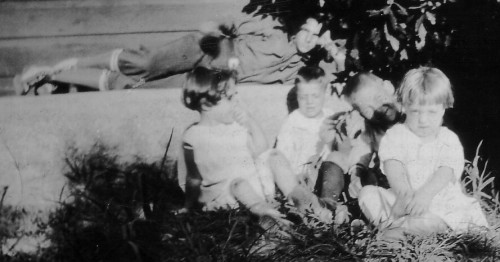
Person lying down may be Oscar; in front are Nena, Charlie,
unknown and Jo
Carmen
never won when she complained to her father. One one summer she
told him she was bored.
Papa had the remedy for that. The
next day he began giving her French
lessons. Another time Carmen
remarked, on the way home from Mass, that the sermon didn’t seem to fit
the
gospel very well. Papa replied, “After
breakfast you can write it as you would have said it.”
There
are a huge number of stories regarding ways in which Charlie was able
to annoy Jo. Here are a few.
Jo
claims she can't count the number of times she was sent to her room
because of Charlie. This is one such case. There was no
talking allowed at the dinner table. One
night, before dinner, Uncle Charlie said
to Aunt Jo, “When I knock twice under the table it means I’m calling
you
stupid.” During dinner Uncle Charlie knocked twice.
Aunt Jo began to cry and accuse Uncle Charlie
of calling her stupid. Papa said that
Uncle Charlie hadn’t said a word, and sent Aunt Jo to her room.
Jo
remembers one time when they each got a box of candies. Charlie
said "there's no need to open both boxes. First we'll share
yours, then mine." Jo agreed, but when they had finished her box,
Charlie claimed "This is my box - you got one too!"
Despite
Charlie's being two years older, Jo and Charlie were in the same grade
from early in Elementary School. Charlie - for some reason -
started a year late and then - for another unknown reason - was held
back early in his school career. No one knows why, as Charlie was
anything but stupid. Jo remembers that, in
high school, Charlie sat next to
her. Once the teacher asked him a question to which he didn't
know the
answers. He grabbed Jo's sheet of paper from her desk and
answered the
question. Then he kept the paper, so that when the teacher asked
Jo a
question, she couldn't answer.
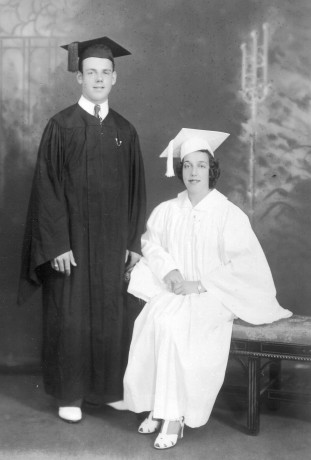 2 yrs apart, Charlie and Jo graduate HS together
2 yrs apart, Charlie and Jo graduate HS together
St. Mary's High School, Paterson, 1938
One
Easter at Lenox Avenue, Charlie got a bunch of little chicks. He
turned them loose in the yard, where they lived - and died - on their
own. One
lived for at least a year. Whenever Jo would go from the house to
the
tennis courts, it would attack her. For some reason, she was the
only family member it would
attack. Once it caught her by surprise and she screamed.
Papa thought something was seriously wrong, and when he found out it
was "just" the chicken, sent her to her room. Finally, once when
Tío Manuel was visiting, Charlie decided it was time to
kill the chicken and eat
it. None of the other siblings were particularly interested in
eating the chicken - who had been a pet - except Jo. She ate it -
she recalls with a smile - with gusto, remembering all the agony it had
cost her.
Papa himself is
the butt of one of these stories. Shortly after getting his first
driver's license at age 53, he bought a brand new 1933 Chevy (for about
$600). Not long thereafter, he was in an accident. He told
the family
there was "a little bit of damage." His son Manny commented,
however,
that the only thing left working was the horn. The car was
repaired,
but from then on the designated driver was Manny.
The car was involved in another family story, this one involving
Charlie had family friend (and future Paterson Fire Chief) Harold
Kane as co-conspirator. Uncle
Charlie wanted to
borrow the car, but asking for it was not his style.
Instead, he and Harold pushed the car out of
the garage and around the corner where Papa wouldn’t hear the motor
start, then
went back into the house to get ready.
Papa was fully aware of what they were doing and when they went
to say
good-bye he told them if they were home by midnight
they could take the car. Then they had
to push the car back into the garage so Papa would hear it start.
Once
Aunt Vickie decided to make dinner, which included
chocolate pudding. It was full of
lumps. Uncle Charlie said, “Hey, Mannie,
let’s play ball.” Aunt Vickie became hysterical and Uncle Charlie was
sent from
the table.
One
night while Aunt Dee and Uncle pie were courting, Maina
and Papa went to a movie. Aunt Dee
called Uncle Pie to invite him over.
After she called, Maina and Papa changed their minds and came
home. When Uncle Pie got to the house,
Aunt Jo
answered the door and said he couldn’t come in because her parents had
come
home. Before she closed the door she
took the ice cream he had brought out of his hands.
Tony
Lagos remembers a story told to him about his father Manny. Manny
wanted to quit high school to get a job, and Papa said "OK, if you
must." Then Papa called the owner of Brogan's Cadillac in Paterson, a
former student of his, and asked if he could get Manny a job.
“Sure, Mr. Lagos” he
said “ I'll get him a good job.” “No,”
said Papa, “get him the dirties, filthiest, most unpleasant job you
have.” Two months later Manny was back at school.
The First In-Law
Certainly the first long-term
relationship among the Lagos kids began when Carmen met Emilio SIGNES
MONFORT on Easter Sunday [at the Spanish Center in Newark]. He
was 24 and she 17. Emilito doesn't know when he proposed to her,
but Papa apparently said "Of course, but you must wait until she
finishes her studies and . . . [??]"
Aunt Jo remembers Carmen crying that day because she REALLY didn't want
to go to the Spanish Center. . . where the family went at least
once a month plus parties etc. . .
At any rate, the courtship lasted for nearly seven years until their
marriage.
Emilio, Emilito's father, must have been around the Lagos family on a
very regular basis during that period, because his picture appears on
countless family photos in the early 30s.
More here?
A few early pix of Emilio - his car, also - more on him in Lagos - 4
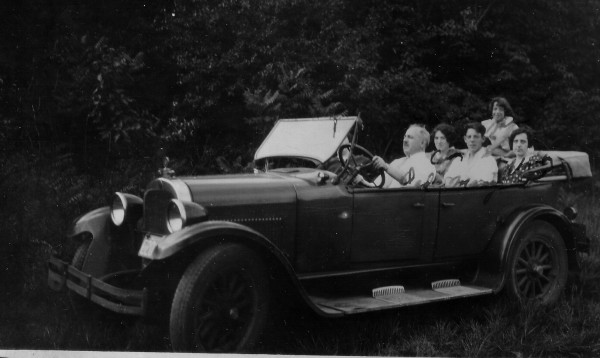
Emilio's car filled with
Lagoses - Papa at the wheel with Carmen, Manny, Jo and Vicky in the back
Who else - that would be married - was dating before 12/20/34?
Dee and Pie yes - Manny & Eileen? not Vicky - & not Charlie
&
Lil or Joe and Jo
Charlie & Lil started dating in HS . . . they corresponded while he
was in college. .
Aunt Dee and Uncle Pie started dating at St. Mary's (1932? 33?)
Relevant Pie-Dee dates
History of Radio in the family - known?
Continue to see what
happens when the Lagos kids marry.
US Lagos History 1 - 1909-1912: Cuba
and Spain
US Lagos History 2 - 1912-1921: The
New York Years
US
Lagos History 3 - 1921-1934: Paterson - the single years
US Lagos History 4 - 1934-1947:
Paterson - the Lagos kids get married
US Lagos History 5 - 1937-1961:
Paterson - grandchildren
US Lagos History 6 - The Lagos
Diaspora
Chapter END
Appendix
1 Cast of Characters
(this list needs editing)
Antonio
LAGOS TOLEDO - AKA Papa - the grandfather of Emilito's generation
Josefa (Pepita) BESTEIRO GRACIANI - AKA Maina - the grandmother of
Emilito's generation
Victorina GRACIANI LORENZO - Maina's mother and "the first
Maina." "Maina" was a name given her by her eldest
granddaughter Carmen Lagos, who mispronounced "Mama Victorina."
Manuel LAGOS TOLEDO - Papa's brother and Victorina's husband
Carmita LAGOS BESTEIRO - Emilito's mother and Maina and Papa's first
child
Manuel (Manolo) LAGOS BESTEIRO - AKA Manny - Maina and Papa's second
child.
Victorina LAGOS BESTEIRO - AKA Vicky - Maina and Papa's third
child
Dolores LAGOS BESTEIRO - AKA Lola, Lolita, Dee, Dee Dee -
Maina and Papa's fourth (surviving) child
Carlos LAGOS [BESTEIRO] - AKA Charlie - Maina and Papa's fifth
(surviving) child
Josephine LAGOS [BESTEIRO] - AKA Jo, Jo Jo, Piti - Maina and Papa's
sixth (surviving) child
??Isabel BESTEIRO GRACCIANI - AKA tía
Isabel and
Aunt Betty - Maina's younger sister,
lived in Havana
Ricardo BESTEIRO LORET DE MOLA - AKA Richard. Victorina's
grandson, son of her son Domingo
Emilito
- Emil SIGNES, son of Carmen LAGOS BESTEIRO. Emilio SIGNES LAGOS
in his Spanish incarnation, Emilito to his parents and to all his Cuban
relatives, and also Emiliet to his Valencian father.
Appendix 2. Addresses
in Paterson: a time line
1921
split
until mid-year, 526 East 83rd
Street; later 321 Market Street, Paterson, NJ
1922 entire
year
321 Market Street (at least through November)
1923
entire year
(by October 1923 they were on 307 Park Avenue
1924
entire year
307 Park Avenue
1925
unclear
307 Park Avenue at least till 18 June,
possibly 315 Park Avenue later in year
1926
unclear
possibly both Park Ave addresses, possible move to 22nd
Street
1927
entire year
almost certainly ended year at 22nd Street (possibly part
of the year at 315 Park Ave)
1928
entire year?
at least most, possibly the entire year at 922 East 22nd
Street
1929
entire year
922 East 22nd Street
1930 split
on April 1, they were at 922 East 22nd Street, probably
moved to 924 during the year
1931 split
924
East 22nd Street and 129 Lenox Avenue
1932 through 1952
129 Lenox Avenue, with children moving out as they were married
















